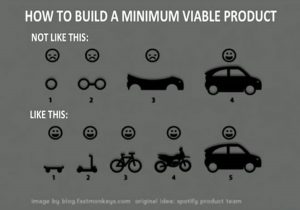The first requirement of a business is a paying customer. You want to define that minimum viable product, and you want to sell it. To understand how to create a minimum viable product you need to know what is a minimum viable product? It is the minimum version of the product that allows your team to collect the maximum amount of learning from the customer with the least amount of effort to achieve product-market fit.
For with the cupcake, the cake, and the wedding cake, if your product is a wedding cake, you don’t have to launch with even a cake, you can launch with a cupcake to see if people like the taste and the frosting and the flavor of what you’re trying to build. The minimum viable business product is the minimum version, maximum learning, least effort, and money to the ultimate goal of product-market fit.
Here is another example of how you build it with the car.

It is going from a skateboard to a scooter to a bike to a motorcycle to a car, in every situation; the user has some benefit/value from what you’re providing, instead of pieces that they can’t use. You want to think like this when you’re building your minimum viable business product.
Minimum Viable Business Product Requirements
Here are the requirements when you’re building your minimum viable product.
- Customer pays for the product
They must pay for it. Remember, that’s the first rule of business. If they’re not paying for your product, then you failed the first rule.
- Customer gets value out of the product
They are going to get value out of that product. They are paying you, and they want to get some value for it.
- Product is sufficient to start the customer feedback loop to help iterate and improve the product.
The product is sufficient to start the feedback loop to help you begin to iterate, improve that product until you find 100% solution and product-market fit.
It’s ultimately a balance between simplicity and sufficiency and finding that type of balance to launch.
Here are some examples of types of minimum viable business products.
-
Wizard of Oz
Pay no attention to the man, there’s nothing behind that curtain. An example of The Wizard of Oz was Zappos shoes. When Zappos launched, what they did was they went to shoe stores, took pictures of shoes, and then put those pictures on their website.
When you bought the shoes, they took your money and went to the shoe store and bought the shoes and mailed them to you. There was nothing behind that curtain, but it met the three requirements. You paid for the product, you got value and it began the feedback loop. There was no structure behind that; we call that the Wizard of Oz.
-
Concierge
The second type is concierge service where somebody does something for you. Groupon, one of the fastest companies to ever hit a billion dollars, when they started would go around knocking on doors of businesses, ask them for discounts, coupons, and then post them online for you. That doesn’t happen anymore.
Try to get your coupons onto Groupon, which has millions and millions of viewers. In the early stages, Groupon was a concierge service: they went out and did it for you. Today, people are knocking on Groupons door to get their coupons on the site.
-
Kickstarter
Kickstarter is where you can buy a product and that funding actually finances the development of that product, and you get it a little way down the road. Now, it’s an example of a minimum viable business product in that you pay for the product, but the actual step two and step three, the customer gains value, and it starts the feedback loop is actually delayed in the process. It’s still an example of a minimum viable business product and a great way to raise funds for production.
- Prototype
And lastly, is to build some kind of a prototype of your actual product or service. Again, it’s a minimum version, but you actually launch a prototype of it.
These are some examples of minimum viable business products.
Design & Build Minimum Viable Product
How do you design and build your MVP?
-
Does it meet the requirements?
Remember, you’ve got to meet those minimum requirements. What was the number one pain point of your customer? And maybe number two, but it’s got to meet that requirement of the pain and the urgency, or else they’re not going to buy it.
-
Is it the MINIMUM Viable Business Product?
When people are building products, a lot of times they want to add on more and more bells and whistles more and more features, functions. What I’ll tell you is you want to strip everything away to the point, that if you take one more thing off, it doesn’t meet the requirements anymore. You want to get it down to the minimum because you want to spend the minimum amount of time and money. That is how to create a minimum viable product.
Remember, you should use the least effort here because you’re going to test it to see if they’ll buy it. You don’t want to build the Cadillac version because it’s going to take more time and money. The minimum version is what you’re looking for.
-
Does it overcome resistance?
Remember, the greatest competition is status quo, doing nothing. You’re customer taking no action. You’ve got to overcome that resistance to change that resistance to get them moving does to your minimum viable business product. Is it easy to use, install, implement? Is it simple? Is it a simple behavior change?
-
What key resources are required?
If you’re going to build this product or service upfront, what are the key resources you need to have figured out?
-
What key relationships and partnerships are needed?
What kind of key partnerships and relationships are needed to make this work?
-
Get going and keep fixing – Don’t wait for perfection!
Bottom line, get going and keep fixing. Don’t wait to perfect your product. I have heard it said before that if you are looking for perfection, you’re waiting too long. If you’re not embarrassed by the first release of your product, you waited too long. Your customers have to know it’s the minimum viable business product.
Give them introductory offers. Let them in for a lower rate because you’re prototyping it and then they understand it’s not going to be perfect, but they want to be part of helping you get it going. Don’t wait for perfection, get going and keep fixing. Then you’re going to continue to iterate that product until you find product-market fit. Most organizations never do.
Summary
Understanding how to create a minimum viable product helps you reduce the time and money in coming up with a 100% solution and achieving the product-market fit. You need to meet the minimum viable product requirements; customers must pay for it, get value and the product should be sufficient to start the customer feedback loop to help iterate and improve the product.

